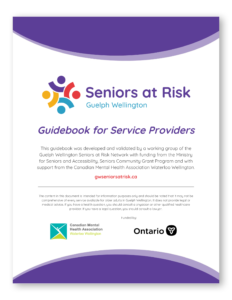Suicide, Social, Substance
As a service provider it is important to understand how depression, suicidal thoughts and plans, social isolation, marginalized identities, and substance misuse can all uniquely lead to increased risk and vulnerability.
Table of Contents
Depression + Suicide
Depression
Depression and suicide are both significant public health issues for older adults. Many older adults are affected by depression, however it should be noted that this is not necessarily a part of normal aging. It is important to consider how recent changes and losses associated with one’s independence (i.e removal of a driver’s license) can have a significant effect on their emotional well-being.
As symptoms can often present similarly, it is also important to distinguish depression from other conditions such as dementia or delirium in order to properly identify treatment. For more information on delirium and dementia, refer to the Functional section.
Primary Care Providers play a critical role in the assessment, treatment and monitoring of depression. If you are concerned about an older adult experiencing depression, it is important to work with their primary care provider and if possible offering collateral information to assist in their clinical assessment.
Depression Resources & Links
For a practical learning experience on depression and older adults we encourage you to visit the Frailty E-Learning Modules
Screening tools for depression with older adults include:
Suicide
Older adults, particularly men have the highest rates of suicide
So why older adults?
Often times they tend to talk about suicide less
Many live alone so there is less of a chance of survival if an attempt is made
Evidence suggests they tend to use more lethal means (i.e. firearms)
(Centre for Suicide Prevention, 1998)
Older adults at higher risk include those (CCSMH, 2017):
- With a personal history (self or family) of suicidality
- Who have experienced a suicide loss
- Experiencing social isolation
- With physical and/or mental health concerns (including depression)
- Experiencing negative life events and transitions
- Recent losses (health, relational, independence)
- Major life changes (environmental, financial)
Suicide Resources & Links
As service providers we need to be aware of and attentive to possible warning signs, screening and prevention practices:
If you are interested in additional training regarding mental health and suicide assessment and intervention, here are several options:
Social
Social Isolation
In addition to seeing social isolation listed as a risk factor above for suicide, socially isolated seniors are more at risk of other negative health behaviours including drinking, smoking, being sedentary and not eating well; have a higher likelihood of falls; and, have a four-to-five times greater risk of hospitalization. (Nicholson, N.R, 2012)
Social isolation is also considered a risk factor for elder abuse.
Social Isolation Resources & Links
For information on social or community programs in Guelph Wellington for your clients, please visit www.wwhealthline.ca.
Caregiver Burnout
Caregiver burnout is a state of physical, emotional, and mental exhaustion that may be accompanied by a change in attitude – from positive and caring to negative and unconcerned. Burnout can occur when caregivers don’t get the help they need, or if they try to do more than they are able – either physically or financially (Ontario Caregiver Organization, 2020).
As service providers we need to be aware that if left unsupported and unaddressed, the effects of a burnt out caregiver may adversely impact their ability to care for a vulnerable older adult.
Caregiver Burnout Resources & Links
Here are some caregiver burden screening tools and resources available to you and the caregivers you work with:
Inclusion and Diversity
Every older adult ages differently and ‘senior’ is no longer defined by a specific age (i.e. historically defined as age 65). For this reason, it is important to note that older adults experience their ‘senior’ years differently depending on many factors. Consider how the intersections of race, culture, gender, disability, sexual orientation, income, and religion play key roles in our lives, affecting our experiences in many ways.
Inclusion and Diversity Resources & Links
- Guidelines for Supporting Adults with a Developmental Disability to/in Long Term Care
- Aging with Pride Waterloo Wellington: committed to creating events, supports and providing education in response to the needs of our community
- Welcoming Streets Initiative: ensuring that downtown Guelph is safe, inclusive, and welcoming for all community members through engagement with vulnerable individuals to ensure they are connected with the services they need
- Legal Clinic Guelph Wellington – Income Assistance: questions about social assistance benefits, such as Ontario Works and/or Ontario Disability Support Program
- Immigrant Services Guelph Wellington: Caring Elders
- The City of Ottawa has released an ‘Equity and Inclusion Lens’ for Seniors: A toolkit to better understand how planning for and provision of care for a diverse population can and should be more equitable and inclusive
- Ottawa’s full Equity and Inclusion Lens Toolkit
- If you have additional questions about your service and health equity, resources for Health Equity Impact Assessments are available through the Ministry of Health and Ministry of Long Term Care
Substance
It is important to distinguish between substance use and misuse.
Substance use
Substance use
Substance misuse
Substance misuse
Substance dependence
Substance dependence
With many older adults taking sometimes complicated regimens of multiple prescribed medications each day, substance misuse is common. Due to physiological changes, older adults are much more vulnerable to the negative effects of substance use and misuse (CCSMH, 2017).
This section also provides a link to smoking cessation resources for your clients.
If you are working with an older adult who would like assistance with their substance dependence, there is support available:
Rapid Access Addiction Clinic
Physicians and/or Nurse Practitioners, Addictions Counsellors and Peer Support Workers are all available to provide assistance to everyone – regardless of substance used.
Community Addictions Services
Homewood’s Community Addiction Services (CADS) provides outpatient addiction treatment for residents in our local community coping with the devastating effects of alcohol, drug and gambling issues.
Behaviour Supports Ontario – Geriatric Addictions
The Community Responsive Behaviour Team in Waterloo Wellington includes a Geriatric Addictions Clinician who provides assessment (with respect to the addiction and responsive behaviours), care planning, and support during transitions for older adults with substance misuse.
Specialized Outreach Services (SOS) and Addiction Support Coordination
Stonehenge Therapeutic Community offers Specialized Medical, Addiction and Mental Health Outreach services to homeless individuals with addiction, mental health, or concurrent issues by providing supportive nursing and counselling, connections to primary care, and referrals to other community services. Addiction Support Coordination (ASC) is also available for older adults living with addiction issues.
Alcohol
Alcohol is the most commonly used and misused substance among older adults (Kuerbis et al., 2014). Alcohol Use Disorder (AUD) and risky alcohol consumption is common among older adults, with reported problem drinking rates ranging from 1–22% (Woodruff et al., 2009).
Supporting older adults with alcohol use disorder requires a continuum of care approach that matches any concurrent issues, severity of impact and life changes/transitions that they may be experiencing. The topic of alcohol use in the senior population is often associated with stigma, which may elicit denial and defensiveness.
Alcohol Resources & Links
Screening and Management of Alcohol Use Disorder in Older Adults:
- Senior Alcohol Misuse Indicator (SAMI) – A brief, senior-specific screening tool designed to start a gentle, non-threatening conversation about alcohol consumption. This approach may be helpful for services that provide outreach care in seniors’ homes and whose first priority is establishing and maintaining rapport. Please note: follow up by a skilled clinician for diagnostic and treatment purposes is required.
- 2019 Canadian Guidelines for Alcohol use Disorder among Older Adults
National Initiative for the Care of the Elderly (NICE)
For additional information on screening for alcohol related issues and older adults visit:
Cannabis
Evidence is limited with regard to the potential benefits and harms of cannabis use, especially among older adults. Physiological changes that impact sleep, mobility, diet, exercise, and overall quality of life, along with issues such as polypharmacy and cognitive decline are all confounding factors in the effects and response of cannabis use in this population (CCSMH, 2019).
Cannabis Resources & Links
Opioids
Globally, according to the World Health Organization people over the age of 50 accounted for 27% of deaths from drug use disorders in 2000, a figure that rose to 39% by 2015. Of those deaths in older adults (age ≥ 65), approximately 75% were linked to the use of opioids (Degenhardt & Hall, 2012; UNODC, 2018).
Opioids Resources & Links
Benzodiazepine Receptor Agonist (BZRAs)
As noted in the release of the 2019 Canadian Guidelines on BZRA Use Disorder, clinicians continue to frequently prescribe these medications despite recommendations that they be avoided whenever possible in older adults. The guidelines highlight several recommendations and strategies for minimizing BZRA use and preventing BZRA Use Disorder.
Smoking Cessation
Older adults have the highest percentage of people who smoke. According to Statistics Canada (2018):
- About 18% of all people between the age of 50 and 64
- About 9% of everyone 65 and up
Oxygen Therapy and Smoking Cigarettes
Smoking around oxygen is extremely dangerous and may cause clothing and hair to catch fire and burn much more vigorously than in air. For your clients: never smoke or allow someone else to smoke nearby whilst using oxygen equipment.
Smoking Resources & Links
Smoking with Dementia
When a person experiences memory loss, smoking may mean an increased fire risk. Some people with dementia may simply forget about smoking if cigarettes and ashtrays are removed from sight, however, if the person stops smoking, they may present with increased anxiety, tension and irritability. There are also ethical considerations around the person’s right to continue to enjoy something that they have enjoyed their whole life even if its bad for them (as could be the case with another substance). If someone with dementia does smoke, those around them should try to make it as safe as possible.


